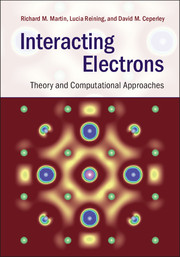Book contents
- Frontmatter
- Dedication
- Contents
- Preface
- Acknowledgments
- Notation
- Part I Interacting electrons: beyond the independent-particle picture
- Part II Foundations of theory for many-body systems
- Part III Many-body Green's function methods
- 9 Many-body perturbation theory: expansion in the interaction
- 10 Many-body perturbation theory via functional derivatives
- 11 The RPA and the GW approximation for the self-energy
- 12 GWA calculations in practice
- 13 GWA calculations: illustrative results
- 14 RPA and beyond: the Bethe–Salpeter equation
- 15 Beyond the GW approximation
- 16 Dynamical mean-field theory
- 17 Beyond the single-site approximation in DMFT
- 18 Solvers for embedded systems
- 19 Characteristic hamiltonians for solids with d and f states
- 20 Examples of calculations for solids with d and f states
- 21 Combining Green's functions approaches: an outlook
- Part IV Stochastic methods
- Part V Appendices
- References
- Index
16 - Dynamical mean-field theory
from Part III - Many-body Green's function methods
Published online by Cambridge University Press: 05 June 2016
- Frontmatter
- Dedication
- Contents
- Preface
- Acknowledgments
- Notation
- Part I Interacting electrons: beyond the independent-particle picture
- Part II Foundations of theory for many-body systems
- Part III Many-body Green's function methods
- 9 Many-body perturbation theory: expansion in the interaction
- 10 Many-body perturbation theory via functional derivatives
- 11 The RPA and the GW approximation for the self-energy
- 12 GWA calculations in practice
- 13 GWA calculations: illustrative results
- 14 RPA and beyond: the Bethe–Salpeter equation
- 15 Beyond the GW approximation
- 16 Dynamical mean-field theory
- 17 Beyond the single-site approximation in DMFT
- 18 Solvers for embedded systems
- 19 Characteristic hamiltonians for solids with d and f states
- 20 Examples of calculations for solids with d and f states
- 21 Combining Green's functions approaches: an outlook
- Part IV Stochastic methods
- Part V Appendices
- References
- Index
Summary
Think globally, act locally.
Summary
Dynamical mean-field theory is designed to treat systems with local effective interactions that are strong compared with the independent-particle terms that lead to delocalized band-like states. Interactions are taken into account by a many-body calculation for an auxiliary system, a site embedded in a dynamical mean field, that is chosen to best represent the coupling to the rest of the crystal. The methods are constructed to be exact in three limits: interacting electrons on isolated sites, a lattice with no interactions, and the limit of infinite dimensions d → ∞ where mean-field theory is exact. This chapter is devoted to the general formulation, the single-site approximation where the calculation of the self-energy is mapped onto a self-consistent quantum impurity problem, and instructive examples for the Hubbard model on a d → ∞ Bethe lattice. Further developments and applications are the topics of Chs. 17–21.
One of the most rewarding features of condensed matter theory is the ability to address difficult problems from different points of view. The preceding Chs. 9–15 present an approach based on perturbation expansions in the Coulomb interaction. In particular, the GW approximation for the self-energy has proven to be extremely successful in describing electronic spectra of many materials, as described in Ch. 13. The methods can be applied to the ordered states of materials with d and f states, for example, ferromagnetic Ni and anti-ferromagnetic NiO, as described in Secs. 13.4 and 20.7. However, the GW and related approximations have difficulties in treating cases with degenerate or nearly degenerate states and low-energy excitations. Present-day methods do not describe phenomena like the fluctuations of local moments in a ferromagnetic material above the Curie temperature or the insulating character of NiO in the paramagnetic phase; more generally, they have difficulty describing strong correlation.
The topic of this chapter and Chs. 17–21 is dynamical mean-field theory, which is also a Green's function method in which the key quantity is the self-energy. However, it is designed to treat strong interactions for electrons in localized atomic-like states, such as the d and f states in transition metals, lanthanide and actinide elements and compounds.
- Type
- Chapter
- Information
- Interacting ElectronsTheory and Computational Approaches, pp. 421 - 456Publisher: Cambridge University PressPrint publication year: 2016



